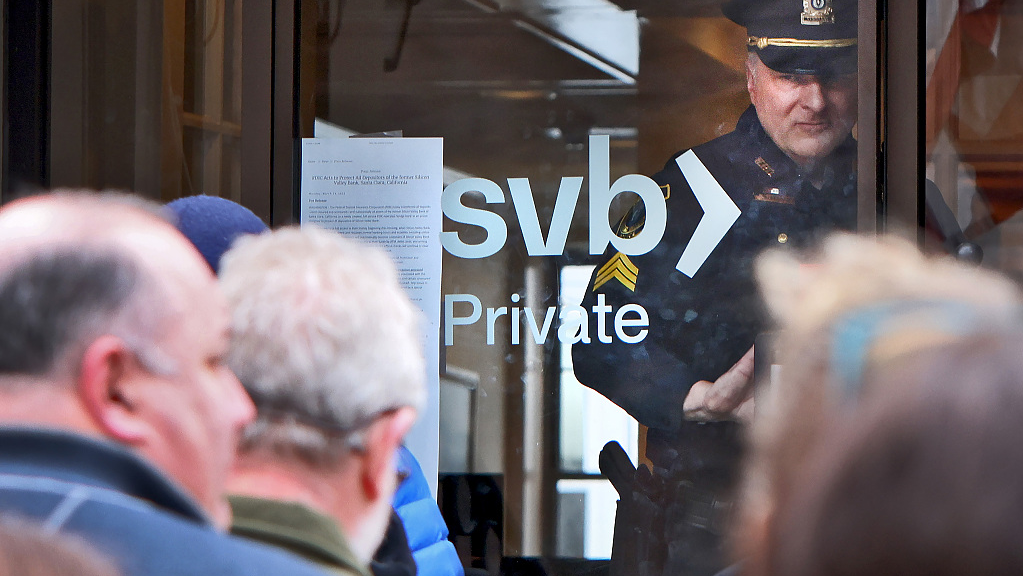
Customers wait in line outside a branch of the Silicon Valley Bank in Wellesley, Massachusetts, U.S., March 13, 2023. /CFP
Customers wait in line outside a branch of the Silicon Valley Bank in Wellesley, Massachusetts, U.S., March 13, 2023. /CFP
Editor's note: Qiao Xue is a professor at the School of Economics at Renmin University of China. The article reflects the authors' views and not necessarily those of CGTN.
The collapse of Silicon Valley Bank (SVB), one of the most prominent lenders in the world of technology start-ups, and the shutdown of Signature Bank, followed by a sharp selloff in regional bank stocks, reveals a new type of financial risk partly driven by U.S. central bank's monetary policy to fight high inflation.
It was a combined result of Federal Reserve's continuous policies to raise the interest rate and deregulation in the banking industry. Fed's tightening policies caused sequential and interlocked changes on both the asset and liability sides of SVB's balance sheet.
On the asset side, since SVB hold much of its assets in the form of U.S. Treasury Securities and U.S. government agency obligations, their low yield rates caused billions of unrealized losses in 2022 with Fed's tightening policy.
On the liability side, as interest rate rises, it became difficult for the technology start-ups to borrow money from the market. As major depositors of SVB, these companies had no other ways but to withdraw their deposits from the bank. Together, SVB faced substantial unrealized loss on the asset side and the outflow of deposits on the liability side.
To deal with the situation, SVB executives decided to sell off the available-for-sale assets, which caused a realized loss of $1.8 billion. If SVB eventually decides to sell its held-to-maturity asset, the unrealized loss of $15 billion would be realized as well. Anticipating these, it became rational for the bank's customers to race to withdraw their money, which led to the collapse of SVB.
48 hours later, U.S. regulators shut down Signature Bank, a regional bank teetering on the brink of collapse, fearing it may threaten the entire financial system.

The Signature Bank headquarters at 565 Fifth Avenue in New York City, U.S., March 13, 2023. /CFP
The Signature Bank headquarters at 565 Fifth Avenue in New York City, U.S., March 13, 2023. /CFP
Will the closure of two banks lead to a systematic bank run? Probably not. On March 12, a joint statement was released by U.S. Treasury, the Federal Reserve Board, and the Federal Deposit Insurance Corporation (FDIC) to assure the market that the FDIC would complete its resolution of SVB in a manner that fully protects all depositors, and announcing a "similar systemic risk exception" for Signature Bank.
Moreover, the Federal Reserve Board announced on March 12 that it would make available additional funding to eligible depository institutions to help assure banks have the ability to meet the needs of all their depositors. The additional funding will be made available through the creation of a new Bank Term Funding Program (BTFP), offering loans of up to one year in length to eligible depository institutions pledging U.S. Treasuries, agency debt and mortgage-backed securities, and other qualifying assets as collateral. The BTFP will be an additional source of liquidity against high-quality securities, eliminating an institution's need to quickly sell those securities in times of stress.
The purpose of these statements and actions was to send a clear message to depositors that their deposits were safe. But whether the risks have dissipated remains to be seen as the market is closely watching Fed's next move on its interest rate target.
Nevertheless, SVB collapse, which BBC has described as "the biggest failure of a U.S. bank" since 2008, provides us with a chance to re-examine the regulation and deregulation processes in the U.S. banking industry.
In July 2010, two years after the 2008 financial crisis, then-U.S. President Barack Obama signed the Wall Street Reform and Consumer Protection Act, known as Dodd-Frank Act. The law announced an end to the so-called laissez-faire regulation approach in America.
One of the key planks in the legislation is that any bank with more than $50 billion in assets should face especially intensive federal supervision. For example, any bank with more than $50 billion is subject to undergo stress tests, to maintain greater financial reserves and to come up with plans for a quick shutdown if faced with an unexpected crisis.
The threshold, however, was lifted to $250 billion signed by then-U.S. President Donald Trump in 2018, supported by Congressman Barney Frank and the executives of SVB. Barney Frank, a primary architect of the Dodd-Frank Act, has become a member of the Board of Directors for Signature Bank in 2015.
The argument was that federal regulations constrained the banking industry's ability to lend to creditworthy customers. Greg Becker, the CEO of SVB, and Harris Simmons, the chief executive of Zions Bancorportion in Utah, expressed the same concerns for onerous federal supervision, complaining that regional banks posed little threat to financial stability while suffering from tough regulation to serve their customers.
Imagine what would happen if the $50 billion threshold were still in place. SVB and Signature would have been subjected to Fed's stress tests and other requirements, which might have avoided their risk-taking behavior and had ensured the banks' safety although their growth spurt might be curbed as well. In the end, it is always a tradeoff between growth and stability, and the government needs to keep a good balance on it.
(If you want to contribute and have specific expertise, please contact us at opinions@cgtn.com. Follow @thouse_opinions on Twitter to discover the latest commentaries in the CGTN Opinion Section.)